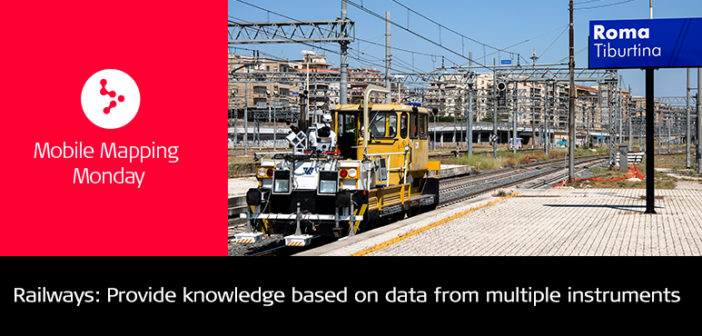Preserving the quality of heritage infrastructure
The Italian geomorphological setting heavily determined the design and construction of the national Italian railway network. Even today, we can find big infrastructures, such as bridges and tunnels, that were built in the last century and are still operational.
To improve the safety of rail traffic, Rete Ferroviaria Italiana (RFI), owner of Italy’s railway network, started an extended maintenance by modernising activities for all heritage infrastructures. The Olmata tunnel project is placed within this context. Olmata is a tunnel located along the oldest railway connection between Rome and Naples. The goal of the project was to determine what tasks can make certain types of train travel safer, in accordance with the existing historical and environmental context.
The 953-metre-long Olmata tunnel has a final coating composed by tuff lithoidic blocks, crossing a single layer of the tough rocks where there is an aquatic groundwater that causes significant hydrogeological problems. Before starting with the maintenance, RFI needed to know in depth the tunnel’s geometry and its status, an information previously unknown. For this purpose, ETS Engineering, an Italian company of engineering and field services, used Leica Geosystems technology to accomplish this demanding task.
Combining technologies for tunnel mapping
ETS Engineering created ARCHITA, a unique system that combines different kinds of measuring technologies – laser scanners, georadar and thermography, all mounted on a service train.
“The system allowed us to collect data in a continuous way at 15-30 kilometres/hour during traffic railway interruptions and nights, with no need to remove electric power and reducing interruption times,” said Gabriele Miceli, CEO at ETS Engineering.

ARCHITA is composed of:
- Leica Pegasus:Two with an integrated thermal camera
The Leica Pegasus:Two allows to detect objects from a moving vehicle using a series of sensors that, together with the post-processing system of the acquired data, allow to obtain certain precisions. This includes:
- Positioning sensors: The positioning sensors work in an integrated way with a tightly coupled Kalman filter that also accepts post-processing additional information such as ground control points.
- Survey sensors: These sensors can also be used as a system for indirect repositioning by adjusting the trajectory. The two scanners are mounted at 90° to each other to perfectly capture the surfaces around the system and not leave shadows in the point cloud. Both profilometers can capture 360° profiles for complete coverage.

The system uses the GNSS and IMU sensors to calculate the vehicle’s trajectory in a predefined reference system. Once the position and the arrangement of a particular point of the system is known through the knowledge of appropriate lever arms, the positions and the arrangement of the various sensors are recalculated and consequently of all images and cloud points they detect.
The precisions of the system depend on the positioning precision of the GNSS system that depend on several factors, such as the number, the type, the visibility and the arrangement of the satellites but also the time interval since the last loss of signal. In ideal conditions, the positioning accuracy of the system, regarding the trajectory, can be equal to 2 cm, while in all other cases the precisions may increase as a function of signal interruption.
2. IDS Radar SRS SafeRailSystem with
• 3 antennas (400 Mhz central frequency)
• 3 radar control units to manage and synchronise collected data
• 1 encoder doppler to measure distances
• 1 additional camera to capture images of the railway base
The Radar SRS SafeRailSystem allows to continuously explore on long distances the railway base with a radar, to evaluate ballast conservation and condition, the level of pollution from fine material, the presence of water inside and below the ballast, the thickness of ballast and to highlight any type of anomaly on the track (failure of the ballast or presence of underground cavities). The system’s optimal resolution is at around 2 m of depth.
Evaluating the structure
The ARCHITA system acquired a lot of information in a single passage, essential for the needs of the project. More specifically:
- Georeferenced 3D point cloud of the tunnel
- Thermographic analysis with information about the coating status
- Georadar analysis with information about the ballast condition
“For the final analysis, we used the Leica SiRailScan software to perform a collision test simulating the passage of different PMO [Profilo Minimo degli Ostacoli] train shapes along the track. In this way it was possible to ensure the safe passage of special type of trains on this track, as had RFI requested,” said Miceli.
With the data that resulted from the analysis, it was possible to:
- Automatically obtain track geometry (gauge and superelevation) and to check the exact position of rails referred to point cloud;
- Simulate the passage of train design shapes to check any kind of collision with surrounding elements;
- Compute the position of electric wires in reference to rail planes and to evaluate any kind of interference with train design shapes; and
- Generate an XLS format file to where summarised collision areas are with related chainage, type of collision and entity of collision.
Mobile Mapping data for informed decision making
“With this type of analysis and after an accurate result check control, RFI could define an appropriate plan of maintenance activities in order to adapt the shape of the Olmata tunnel,” said Miceli.
This mobile mapping project allowed to configure a mobile system as a valid alternative to the traditional topographic survey method, which requires extremely long times with a huge impact on the railway traffic exercise. ETS Engineering could connect different results obtained from different instruments combined in a single solution to provide detailed knowledge. In this way the RFI received all necessary information to support planning activities of maintenance of the entire infrastructure assets.














